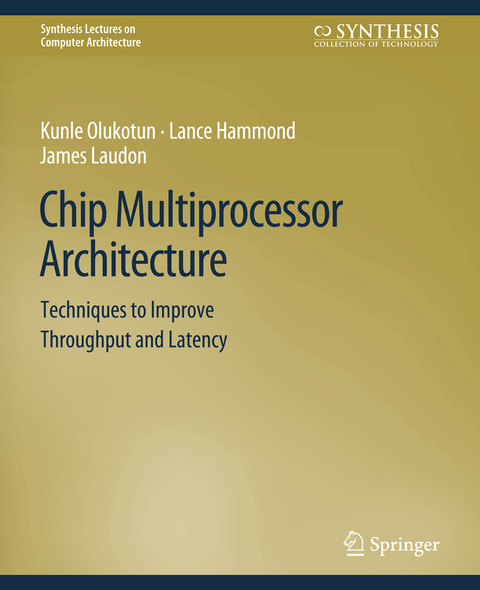Chip multiprocessors - also called multi-core microprocessors or CMPs for short - are now the only way to build high-performance microprocessors, for a variety of reasons. Large uniprocessors are no longer scaling in performance, because it is only possible to extract a limited amount of parallelism from a typical instruction stream using conventional superscalar instruction issue techniques. In addition, one cannot simply ratchet up the clock speed on today's processors, or the power dissipation will become prohibitive in all but water-cooled systems. Compounding these problems is the simple fact that with the immense numbers of transistors available on today's microprocessor chips, it is too costly to design and debug ever-larger processors every year or two. CMPs avoid these problems by filling up a processor die with multiple, relatively simpler processor cores instead of just one huge core. The exact size of a CMP's cores can vary from very simple pipelines to moderately complex superscalar processors, but once a core has been selected the CMP's performance can easily scale across silicon process generations simply by stamping down more copies of the hard-to-design, high-speed processor core in each successive chip generation. In addition, parallel code execution, obtained by spreading multiple threads of execution across the various cores, can achieve significantly higher performance than would be possible using only a single core. While parallel threads are already common in many useful workloads, there are still important workloads that are hard to divide into parallel threads. The low inter-processor communication latency between the cores in a CMP helps make a much wider range of applications viable candidates for parallel execution than was possible with conventional, multi-chip multiprocessors; nevertheless, limited parallelism in key applications is the main factor limiting acceptance of CMPs in some types of systems. After a discussion of the basic pros and cons of CMPs when they are compared with conventional uniprocessors, this book examines how CMPs can best be designed to handle two radically different kinds of workloads that are likely to be used with a CMP: highly parallel, throughput-sensitive applications at one end of the spectrum, and less parallel, latency-sensitive applications at the other. Throughput-sensitive applications, such as server workloads that handle many independent transactions at once, require careful balancing of all parts of a CMP that can limit throughput, such as the individual cores, on-chip cache memory, and off-chip memory interfaces. Several studies and example systems, such as the Sun Niagara, that examine the necessary tradeoffs are presented here. In contrast, latency-sensitive applications - many desktop applications fall into this category - require a focus on reducing inter-core communication latency and applying techniques to help programmers divide their programs into multiple threads as easily as possible. This book discusses many techniques that can be used in CMPs to simplify parallel programming, with an emphasis on research directions proposed at Stanford University. To illustrate the advantages possible with a CMP using a couple of solid examples, extra focus is given to thread-level speculation (TLS), a way to automatically break up nominally sequential applications into parallel threads on a CMP, and transactional memory. This model can greatly simplify manual parallel programming by using hardware - instead of conventional software locks - to enforce atomic code execution of blocks of instructions, a technique that makes parallel coding much less error-prone. Contents: The Case for CMPs / Improving Throughput / Improving Latency Automatically / Improving Latency using Manual Parallel Programming / A Multicore World: The Future of CMPs
Kunle Olukotun is a Professor of Electrical Engineering and Computer Science at Stanford University. Olukotun led the Stanford Hydra project which developed the first chip multiprocessor (multicore chip) with support for thread-level speculation. Using insights gained from the Hydra project, Olukotun founded Afara Websystems to demonstrate the benefits of chip multiprocessor technology for high-throughput, low power server systems. Afara microprocessor technology, called Niagara, was acquired by Sun Microsystems. The Niagara based Sun Fire CoolThreads servers have become one of SunaEURO (TM)s fastest ramping products ever. Olukotun is actively involved in research in computer architecture, parallel programming environments and scalable parallel systems. Currently, Olukotun directs the Stanford Pervasive Parallelism Lab (PPL) which seeks to proliferate the use of parallelism in all application areas. Olukotun is a Fellow of the ACM. Olukotun received his Ph.D. in Computer Engineering from The University of Michigan.
James Laudon is a Distinguished Engineer with Sun Microsystems. His areas of expertise include multithreading, multiprocessors, and performance modelling. He is currently focused on the architecture of future generations in the UltraSPARC T1 chip multiprocessor line. James joined Sun in July of 2002 through the acquisition of Afara Websystems.
Contents: The Case for CMPs.- Improving Throughput.- Improving Latency Automatically.- Improving Latency using Manual Parallel Programming.- A Multicore World: The Future of CMPs.



